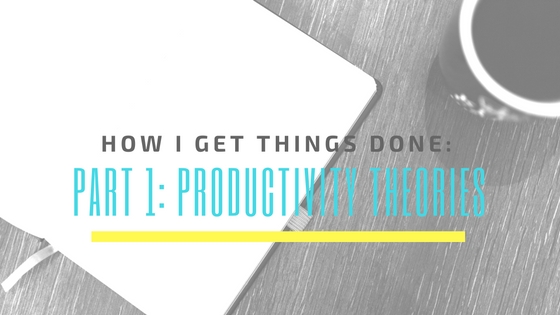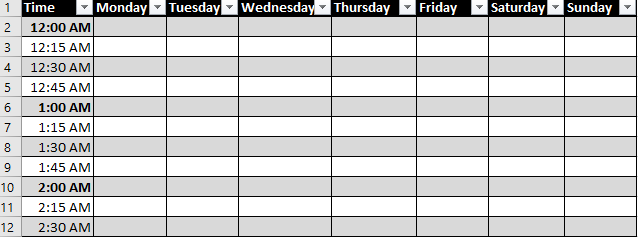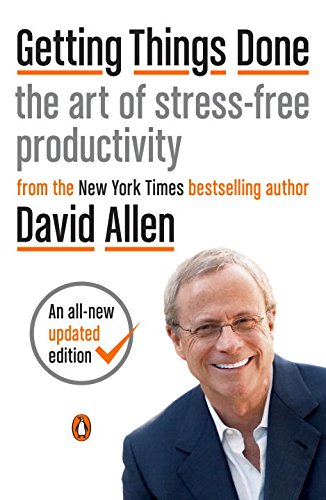
In my search for the best way to get things done, I read many books by productivity “gurus.” It seemed so easy. I would simply follow the guidelines in the book, and magically, I’d be productive. Of course, you and I both know that there is more involved in being productive and getting things done than just that, and that’s oversimplifying the productivity genre by a lot. Let’s just say that by the time I became a Ph.D. student, I was pretty desperate for something I could actually maintain and follow. These are the big influencing factors that have changed the way I work from a crazy disorganized haphazard they-exist-everywhere system of notes and lists to the much more streamlined system I now use, that I’ll discuss in detail in the second part of this series.
Early Productivity Influencers
I was pretty good at making lists. It was just that list-making alone wasn’t working anymore. I was using a bullet journal-type system long before that became popular and what it is now. I’d have my notebook that went everywhere with me, and in it I would make notes, jot down ideas for papers, and write my lists of things I needed to do. I would journal, I would write snippets of conversation, I would write poetry. It’s not that it was a terrible way of doing things, but it wasn’t allowing me to be as efficient as I knew I could be.
Developing a better to-do list
My list was scattered everywhere. I had tasks written in class notebooks, ideas for future research scrawled in the margins of books, notes and lists everywhere. In fact, my purse was like a bottomless pit of old to-do lists. It was a mess! Sometime around the time when I thought “This is not an efficient way of making sure I keep track of everything,” I picked up a Palm Pilot and started using Microsoft Outlook. I moved all my lists, ideas, notes, etc. to the computer.
I also read, sometime around this time, a book that talked about the most efficient ways to make lists, Brian Tracy’s Time Power*.
Brian Tracy’s Time Power

Reading this book was the first step to getting more done. There are some very good suggestions in the book. For example, when writing goals, don’t write “I want to own a successful business.” Write it, instead, as though it has already happened. You’ll also want to take a moment to rewrite those goals daily. Why? It helps put you into the mindset of already being where you want to be, and it helps to motivate you to get more things done.
There’s also the idea of the “brain dump.” Get everything down. All of it. Set a timer. List out every single thing you need to do. Then, from that list, choose what you will work on today. If something new crops up, don’t just do it now, add it to your to-do list first. Otherwise, you wind up putting out fires all day and not working on what needs doing from your original list. You’ll also want to prioritize your goals – A, B, and C.
Once I started following Tracy’s system, I started to feel much more in control of my to-do list, but I felt as though there were more I could be doing to really be productive and keep track of everything.
Seven Habits for Highly Effective People

I’m going to be honest here. I’ve not yet made it all the way through Covey’s seminal time management book*. It’s not one that really clicked with me and the way my brain works, and I’ve started it over and over and over. I don’t think that I will finish it. For some people, this book really clicks. For me, there were things I took from it – like separating out the roles that I play in life, beginning with the end in mind, giving value to others before you ask for value from them, and being pro-active and not reactive. Instead of reacting to things as they come up, it’s important instead to look at what might crop up and take actions necessary to attain desired results. I also started to look more at how balanced my life was and to make renewing myself, taking care of myself, and developing myself more of a priority than I had been. It actually seems, now on reflection, that I’ve internalized a lot more from that book than I initially thought I had.
In fact, after reading Seven Habits, I started separating out my to-do list into role-based to-dos. I still felt overwhelmed by the list, but it was sorted, I could see how things related to the different hats I was wearing (student, scholar, teaching assistant, research assistant, budding novelist, homeschooling mom, friend, etc.).
The First Big Game Changer: Time Management from the Inside Out

Julie Morgenstern’s Time Management from the Inside Out* is another influential book on time management that has shaped the way I get things done. I came to this book after I’d read Covey’s, and I was already familiar both with her book on organizing (it’s worth checking out if you feel overwhelmed by the task of ensuring that everything you own has a home) and her theory that one should not check emails first thing. I’ll talk more about that in a moment.
What makes Morgenstern’s book so helpful is that she talks about some of the internal hurdles we have when it comes to getting things done. Whether it’s perfectionism, or a fear of failure (or a fear of success), imposter syndrome, or general overwhelm, our mental states can create barriers to accomplishing the things on our to-do list no matter how bad we think we want to get them done.
The Right Tools Make a HUGE Difference!
She also spends some time talking about finding the system that is right for you. As I wrote in my introduction to this series of posts on getting things done, it’s really important that the system we use, planners we use, etc. fit our personalities and lifestyles. I no longer use that Palm Pilot because I’m working from home, and I’m at either my desktop computer, or I have my laptop computer. Sometimes, I use the tablet if I need something ultra-portable. Cloud-based software really makes streamlining all of that very easy. If I’m on the go, and I really have to be abreast of what’s going on in a Facebook group or I’m waiting for an important email, I have my phone equipped with apps that make tracking everything easy. But I don’t use multiple different platforms to track things. I like to have everything streamlined and in one place. Morgenstern points out that it’s really important that we use the tool and system that works best for our needs, not the tool or system that seems the flashiest or that works well for someone else. This is why taking stock of your needs, as I did in the first post, is so important.
The Importance of Knowing How you Spend Your Time
If you haven’t done a time map of how you spend your time, I strongly suggest doing one. Every time you change activities for a week, write down the time and what the activity is. There is software for tracking this online, but I found that the old-fashioned pen and paper method is best here. I tracked in 15 minute increments the first time I did this. It’s amazing how much time I thought I was using for pursuing my goals and how little time I was actually using. If you want to get fancy, note your energy levels as well and when you start to feel hungry. This is really instrumental for determining how best to organize your day in terms of what sorts of tasks you work on when. For example, I try to do all of my writing and intense editing activities when I have the most energy and I save social media marketing scheduling for times when I have lower energy or when I know I will have lots of interruptions. Doing a time audit from time can really help you see where you’re spending your time.

I’m also going to let you in on a secret. I time a LOT of my activities. I know exactly how long it takes to write 500 words. I know how long it takes to edit a fairly polished abstract. I know how long it takes to make a single pair of earrings. I know how long certain lunch options take, how long it takes to get out of the door with 2 children under the age of 3, a teenager, and a husband. Knowing how long things take is vital to planning a day and being realistic about how many tasks you can accomplish in one day.
Don’t Check That Email First Thing!
There is a lot of great info packed into Morgenstern’s book. Like anything, I have my takeaways that I’m discussing here, and there were things that didn’t apply to me then (as a graduate student) and don’t apply to me now (as a solo entrepreneur working from a home office). The other big piece of advice that I follow most days is this one. I try to make sure I work on one big project before checking my email for the day. It is so easy to get caught up in email and have that be the only thing one does that entire day. While I like to maintain “inbox zero” (more on that coming on the next page), that’s not always possible. Some days, when there is a lot to do, I scan the email after I’ve completed my one big thing for any urgent emails/emails I need to respond to within that day/etc. and then that’s all of the processing I do with my email for that day.
The Life-Changing Power of David Allen’s Getting Things Done

While Julie Morgenstern’s book was a “game changer,” this next productivity book was a life-changer. While the things David Allen talks about in his Getting Things Done are not necessarily earth-shattering, the way he presents them can change someone’s approach to life, time, and task management dramatically. When I first read the book, I felt as though I finally had found gold. I know this sounds like an insane amount of praise for a book, but by far it’s the framework that has worked the best for me over the years I’ve used it. There are many nuances to his system, but here are the basics:
You Have to Collect All the “Stuff” and Process it
That’s right. Creating your list of “stuff” involves more than just writing something down. You also have to process it and figure out what that thing is. Is it something for you? Is it something to delegate? Is it something you can just delete now? Is it something that takes less than 2 minutes to do (do it now). I find that doing a regular (timed) mind sweep can help capture stuff. Here’s a trigger list to help with that.
He calls the collection places “inboxes.” If you are like I can be, that may include your purse or wallet, your actual desk inbox, the email inbox, your voice mail, your notebook, Facebook, etc. The key to managing inboxes? You should have as few as possible and as many as are necessary. I am still working on getting my number of inboxes down, but this is one area where I like division. I like to know, at a glance, whether an email is related to my blog, a client I’m having a long-term partnership with, my personal life, etc. Figure out what works best for you and go with it. I have more email inboxes than I think David Allen himself would be comfortable with – but it’s what works for me and the way my brain works.
Is it an Action Item or a Project?

How many times have you had something hanging out on a “to-do” list keep getting pushed to the side? I (and David Allen) bet that it is probably a project, and not a true actionable item. You see, you can’t just “do” projects because they require multiple steps. This process – the idea that you might have something on your list like “write a paper on Kant’s political theory” that keeps getting pushed back because it’s truly a project and not an actionable step – blew my graduate student mind. Of course! It seems so simple to say that of course writing a term paper is a “project” and not a task.
Before such a project can be completed, one has to first figure out what the next actionable step is. Perhaps in the case of the term paper it is “narrow down my topic” or “put together a working outline.” (For the record, even before I research something, I jot down a very loose outline of what I think I will want to write about. It helps me to focus my research and weed out sources that will not be of use to me really quickly). Perhaps I’ve already compiled all my source material and my next step is to read the journal article that I think might be a key piece. No matter what it is, it’s important to identify this next actionable step for each project. Sometimes the step is apparent, sometimes you need to brainstorm or do a mind map in order to determine what really is the next step. This process of defining the smallest next step is what is key to me getting a lot of things done and being really productive. Once things are broken down that way, it is really a lot easier to make progress on big projects.
After breaking projects down into the next actionable item and determining exactly what needs to be done, you then organize those items by context – i.e. phone calls, emails to send, etc. I also tend to organize by where I need to do something – i.e. at the sewing machine, at the computer, at my creative desk, in the library, in the kitchen, etc. That way, when I find myself in that particular context, I can tackle many similar action items at once.
The Weekly Review
While there are other components of Allen’s method that are worth discussing (keeping a tickler file, for example), but I’ll leave those out for now. The other big and very important part of following Allen’s system is the weekly review. Once a week it’s important to go through all the “stuff” from the earlier week in preparation for the following week. What was accomplished? What still needs to be done? What do you need to follow up on? What are the next actions for projects? What are new things that came up throughout the week? An outline of what to do for the weekly review can be found here.
Looking Forward:
In part two of this three-part series, I’m going to talk about the system I use to help me get things done and how I set it up. In part three, I will talk about the actual process I use to get things done. Meanwhile, here are some things to think about for developing your own system:
- Is there a thought process that is holding you back from managing your time efficiently?
- Is the way you’re tracking your tasks the most efficient way possible?
- What are the things that keep getting put off? Is there a better way of framing those to make it easy for yourself to make progress on them?
- How are you spending your time? How could you better spend your time?
- What are all the things that need acting on? Are these in line with your current goals?
- Are you reviewing your goals and your projects and your tasks regularly to make sure you aren’t missing important items that need action?
What do you think of this series so far? Do you have any questions for me? Is there someone I should read in addition to the people I’ve mentioned? Post your thoughts in the comments!
*Affiliate link







